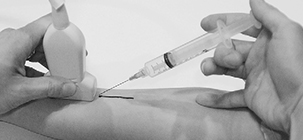Musculoskeletal Ultrasound
Jump
to Tests
Muscle and skeletal ultrasound can help diagnose various injuries and chronic conditions, such as tendonitis, bursitis, carpal tunnel syndrome, rotator cuff tears, joint problems, and masses such as tumors and cysts. Often, the test can provide a clearer picture of your musculature, tendons, and other affected structures, along with an X-ray, CT, or MRI to support accurate diagnosis.
It allows the patient to move during the test. Hence allows dynamic examination of the affected area.
Notably, the scan helps the orthopedic/ doctor to learn the exact location of an injury and how movement affects the area of concern.
What happens during Musculoskeletal Ultrasound?
During a musculoskeletal ultrasound, a hand-held transducer scanning device is pressed on your skin. The transducer sends inaudible, high-pitched sound waves traveling through the body. A layer of gel is applied to the transducer, which helps it transmit and receive sound waves. Dense substances like bones reflect waves while they pass through liquids, including water. The transducer converts wave activity into accurate pictures of muscles, tendons, and other structures.
Musculoskeletal ultrasound doesn’t require getting an injection of a contrast agent. No health risks are associated as it doesn’t use radiation, like in X-rays. As you are not confined to any close space, so you won’t experience claustrophobia or any other discomfort.
What does the Musculoskeletal Ultrasound detect?
The test can detect acute injuries (muscle tears) to chronic orthopedic conditions (rheumatoid arthritis). If you are experiencing pain, swelling, or burning sensation with or without inflammation, musculoskeletal ultrasound is recommended to diagnose the root cause. Anyone of any age is eligible for the test.
Instructions:
- Wear loose and comfortable clothing.
- Avoid applying any cream and lotion to the skin.
- Don’t wear any ornaments or metal jewelry.




